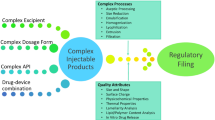Abstract
A nondisintegrating, controlled release, asymmetric membrane capsular system of flurbiprofen was developed and evaluated for controlled release of the drug to overcome some of its side effects. Asymmetric membrane capsules were prepared using fabricated glass mold pins by phase inversion process. The effect of different formulation variables was studied based on 23 factorial design; namely, level of osmogen, membrane thickness, and level of pore former. Effects of polymer diffusibility and varying osmotic pressure on drug release were also studied. Membrane characterization by scanning electron microscopy showed an outer dense region with less pores and an inner porous region for the prepared asymmetric membrane. Differential scanning calorimetry studies showed no incompatibility between the drug and the excipients used in the study. In vitro release studies for all the prepared formulations were done (n=6). Statistical test (Dunnett multiple comparison test) was applied for in vitro drug release atP>.05. The best formulation closely corresponded to the extra design checkpoint formulation by a similarity (f2) value of 92.94. The drug release was independent of pH but dependent on the osmotic pressure of the dissolution medium. The release kinetics followed the Higuchi model and the mechanism of release was Fickian diffusion.
Similar content being viewed by others
References
Santus G, Baker RW. Osmotic drug delivery: a review of the patent literature.J Control Release. 1995;35:1–21.
Theeuwes F. Elementary osmotic pump.J Pharm Sci. 1975;64: 1987–1991.
Theeuwes F, Saunders RJ, Mefford WS, inventors. Process for forming outlet passageways in pills using a laser. US parent 4 088 864. May 9, 1978.
Herbig SM, Cardinal JR, Korsmeyer RW, Smith KL. Asymmetric membrane tablet coatings for osmotic drug delivery.J Control Release. 1995;35:127–136.
Thombre AG, Cardinal JR, DeNoto AR, Gibbes DC. Asymmetric membrane capsules for osmotic drug delivery. II. In vitro and in vivo drug release performance.J Control Release. 1999;57:65–73.
Thombre AG, Cardinal JR, DeNoto AR, Herbig SM, Smith KL. Asymmetric membrane capsules for osmotic drug delivery. I. Development of a manufacturing process.J Control Release. 1999;57:55–64.
Lin YK, Ho HO. Investigations on the drug releasing mechanism from an asymmetric membrane-coated capsule with an in situ formed delivery orifice.J Control Release. 2003;89:57–69.
Marsh CC, Schuna AA, Sundstorm WR. A review of selected investigational nonsteroidal antiinflammatory drugs of the 1980s.Pharmacotherapy. 1986;6:10–25.
Gilman AG, Rall TW, Taylor P.Goodman and Gillman’s The Pharmacological Basis of Therapeutics. New York, NY: Pergamon Press; 1990.
British Medical Association and Royal Pharmaceutical Society of Great Britain.British National Formulary 45. London, UK: British Medical Association and Royal Pharmaceutical Society of Great Britain; 2003.
Thaller VT, Kulshrestha MK, Bell K. The effect of pre-operative topical flurbiprofen or diclofenac on pupil dilatation.Eye. 2000; 14:642–645.
Chandran C, Roy A, Saha RN. Flurbiprofen: a review.Indian J Pharm Educ. 2005;39:22–26.
McClelland GA, Sutton SC, Engle K, Zentner GM. Solubility modulated osmotic pump: in vitro/in vivo release of diltiazem hydrochloride.Pharm Res. 1991;8:88–92.
Zentner GM, McClelland GA, Sutton SC. Controlled porosity solubility and resin modulated osmotic drug delivery systems for release of diltiazem hydrochloride.J Control Release. 1991;16:237–244.
Martin A.Physical Pharmacy. New Delhi, India, B. I. Waverly Pvt Ltd; 1999.
Rawlins EA.Bentley’s Textbook of Pharmaceutics. London, UK: Bailliere Tindall 2004.
Bennett PN, Brown MJ.Clinical Pharmacology. London, UK: Churchill Livingstone; 2004.
Chien YW.Novel Drug Delivery Systems. New York NY: Marcel Dekker Inc; 1992.
Najib N, Suleiman M. The kinetics of drug release from ethyl cellulose solid dispersions.Drug Dev Ind Pharm. 1985;11: 2169–2181.
Desai SJ, Singh P, Simonelli AP, Higuchi WI. Investigation of factors influencing release of solid drug dispersed in wax matrices. III. Quantitative studies involving polyethylene plastic matrix.J Pharm Sci. 1966;55:1230–1234.
Higuchi T. Mechanism of sustained action medication, theoretical analysis of rate of release of solid drugs dispersed in solid matrices.J Pharm Sci. 1963;52:1145–1149.
Hixson AW, Crowell JH. Dependence of reaction velocity upon surface and agitation: I—theoretical consideration.Ind Eng Chem. 1931;23:923–931.
Korsmeyer RW, Gurny R, Doelker EM, Buri P, Peppas NA. Mechanism of solute release from porous hydrophilic polymers.Int J Pharm. 1983;15:25–35.
Avdeef A. pH-metric solubility 1: solubility pH profiles from bjerrum plots. Gibbs buffer and pKa in solid state.Pharmacy and Pharmacology Communications. 1998;4:165–178.
Author information
Authors and Affiliations
Corresponding author
Additional information
Published: July 7, 2006
Rights and permissions
About this article
Cite this article
Philip, A.K., Pathak, K. Osmotic flow through asymmetric membrane: A means for controlled delivery of drugs with varying solubility. AAPS PharmSciTech 7, 56 (2006). https://doi.org/10.1208/pt070356
Received:
Accepted:
Published:
DOI: https://doi.org/10.1208/pt070356




